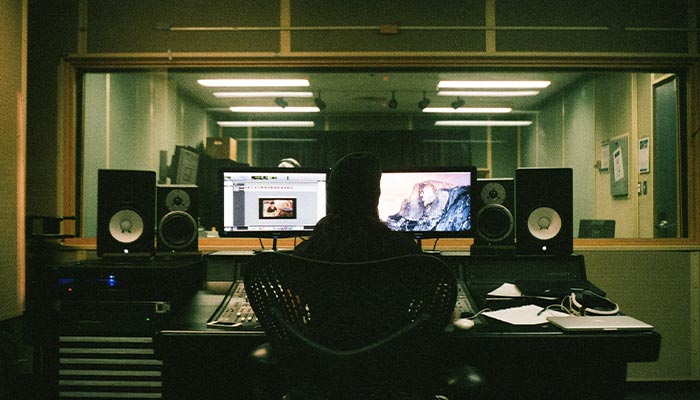
Someone who is not involved in music production may not even be aware that there are different kinds of audio formats, each one with specific characteristics that make it the ideal choice for a particular use. They might not wonder which popular audio file format is best i.e. WAV vs MP3.
If you were a teenager in the mid-2000s, you probably owned an MP3 player before switching to the much fancier iPod. MP3 players were ground-breaking and could hold thousands of songs, something unheard of in the music market until then.
But how did we manage to upload so much music to a device with such small disk space? Because MP3s, compared to WAV files, are compressed to occupy less disk space. However, this sacrifices the audio quality.
Nowadays, you may come across half a dozen different audio file formats without even realizing it. On the other hand, knowing the specifics of each audio file format will help you choose the best one for whichever project you’re working on.
This article will look into the most common audio file formats. If you’re a music producer or want to become an audio engineer, this knowledge is crucial. It will be helpful to you for the time being. Likewise, if you want to reach an optimal sonic experience when listening to music, then you must know what preferred format ensures the best audio experience. Let’s dive in.
The main difference between digital audio file types lies in whether the file is compressed or not. Compressed files store less data but also occupy less disk space. However, compressed files have lower audio quality and can feature compression artifacts.
File formats are divided into three categories: uncompressed, lossless, and lossy.
Bitrate, the amount of data converted into audio, is a crucial factor here. The bitrate of audio CDs is 1,411 kbps (kilobits per second). MP3s have a bitrate between 96 and 320 kbps.
Can the human ear hear the difference between a compressed and uncompressed audio file?
Absolutely, with the right equipment and training.
Should you worry about it?
No, unless you’re working in the music industry or an audiophile.
I’ve been involved in the music industry for over a decade, and I honestly can’t hear the difference between an MP3 audio file at 320 kbps and a standard WAV file. I don’t have the most trained ear in the world, but I’m no casual listener either. I can say for certain that some music genres with richer sounds, like classical music or jazz, are more affected by compression than other styles, like pop or rock music.
If you’re an audiophile, you likely have the appropriate audio equipment that ensures an authentic and transparent reproduction of sounds. With the right headphones or sound system, you will be able to hear the difference between formats.
How does this difference in quality sound? The higher the volume, the more evident the differences. The overall sound is less defined and classical instruments tend to blend together. In general, the tracks lose depth and richness.


If we have the technology to deliver high-quality audio on CDs and as digital downloads, then what’s the purpose of low-quality audio? Many listeners might not even be aware of the difference in terms of quality between these formats. Yet each one of them played a fundamental role in the evolution of the music industry over the last few decades. In particular, the rise to fame of MP3 and WAV formats defines the history of recorded music.
These two types of files store audio data for PCs and portable devices. Making it possible for everyone to access music without purchasing it in a physical format (tape, cd, or vinyl). The WAV format has been the high-quality format par excellence. Yet MP3 files were the ones that took the music industry by storm.
There’s a precise moment in time when lower quality audio files became the most popular among young music listeners: with the rise of peer-to-peer music software in the late 90s and early 2000s.
Peer-to-peer file-sharing services allow distributing and downloading of all sorts of digital music available in a P2P network. Everyone within the network can download and provide certain content to others. Later versions of P2P networks fully decentralized and don’t have a core server.
Music was the first content to be widely shared in these networks, simply because of its popularity among young people and the lighter format compared to movies. For instance, MP3 files were by far the most common format as they would decrease bandwidth use while providing good-quality music.
Back then, most people were not particularly interested in the format quality, as long as they could get their music without spending a dime. Since then, things have changed, with streaming platforms priding themselves on offering streaming formats that offer standard CD quality, for the best streaming performance and an optimal sonic experience.
Lightweight, easy to share, and with good enough audio quality: people downloaded and shared MP3 files non-stop in P2P networks; Napster, the first peer-to-peer file sharing service to reach worldwide fame, had 80 million active users at its peak.
Napster’s fame was short-lived: active between June 1999 and July 2001, the service was shut down after losing a court case against some of the major record labels at the time. After Napster, dozens of other P2P services led the file-sharing movement, many still active today.
The quality of the MP3 files available in file-sharing service was, quite often, sub-par. Especially if you were looking for something rare (old songs, unreleased recordings, little-known artists and so on), there was a big chance you’d end up with a corrupted file or one with such low quality that’d make the music unenjoyable.
Aside from the source of the original recordings, another factor that lowered the quality of music downloadable from P2P services was the quality loss as the album was shared with more and more users. The more people downloaded and shared an album, the more chances the file will lose essential data in the process.

Twenty years ago, the internet wasn’t nearly as accessible as it is today, and therefore the costs for bandwidth were extremely high. As a result, P2P users opted for smaller-size formats, even if sometimes that would compromise the quality of the file. For example, WAV files use approximately 10 MB per minute, while an MP3 file requires 1 MB for the same audio length. Hence the popularity of MP3 files grew immensely in a matter of months, especially among young music listeners.
You may even say that the possibility to “decrease” the audio quality of a track was the first step towards the music industry as we know it today, governed by music streaming platforms and digital downloads. Low-quality audio detached sound from the physical formats it was restrained in for over a century and allowed listeners to discover and share new music at ground-breaking speed compared to earlier times.
P2P networks made music available to anyone, anywhere. Before this revolution, finding rare recordings or discovering unknown artists was extremely difficult; this infinite abundance removed the bottleneck caused by major record labels, giving listeners the opportunity to discover more music and for free.
Obviously, this didn’t please the major players in the music industry at the time. Labels filed lawsuits and fought to shut down websites. Nevertheless, Pandora’s Box was open, and there was no way back. That was the most significant change in the music industry since the invention of vinyl records in the 1930s.
The increasing internet bandwidth and power of personal computers gave people the chance to share more and more media files online. The mid-2000s saw hundreds of millions of people engaged in file sharing. At the time, the majority of Americans believed it was acceptable to download and share content online. As a matter of fact, the massive increase in internet bandwidth between the 2000s and 2010s was primarily caused by the growing number of users of P2P services.
As an uncompressed format, WAV files still sound better vs MP3 files. However, the purpose of the MP3 files was to make music, and especially music that was rare, widely accessible to a worldwide audience.
The final chapter of this story (at least so far) is the rise of music streaming services. As peer-2-peer websites dramatically changed the music industry landscape twenty years ago, so did the audio streaming providers that rose to fame at the end of the 2000s.
The process of freeing music from its physical constraints and making it accessible to anyone led to an ever-increasing audience interested in higher audio quality and easier accessibility to music. Audio streamers offer enormous music libraries, accessible through multiple devices through a subscription program.
Once again, the audio quality of the music you can stream on these platforms is affected by the audio file format they use. Some major players, like Tidal and Amazon Music, offer different high-resolution audio streaming options. Qobuz, a music platform specializing in classical music but constantly expanding its catalog, provides high-resolution audio and standard CD quality. Spotify doesn’t offer hi-res music streaming and currently provides AAC audio format at up to 320kbps.

WAV files reproduce the sound in its original format. This ensures the highest quality and fidelity of sound. However, it all comes down to what you’re listening to and how you listen.
If you’re listening to the latest K-pop hit on your cheap earphones while on the train, the audio format won’t make a difference.
On the other hand, let’s say your passion is classical music. you want to try the unique immersive sonic experience this genre provides. In that case, uncompressed WAV files combined with the right hi-fi sound systems will take you on a sonic journey no other format can offer.

Musicians and audiophiles should always go for formats that undergo the least possible processing when converted from analog to digital, namely WAV and AIFF audio files. If you enter a recording studio with MP3 files you want to include in your next album, technicians will laugh at you.
When recording an album, musicians need the best quality audio because their songs are recorded, mixed, and mastered by different professionals. All of them will need to have access to the whole frequency spectrum to provide a final result that sounds professional on all devices.
Even if you’re an amateur musician, you still want to use uncompressed audio formats as the original source. You can convert WAV to an MP3 file format, but you can’t do it the other way round.
If you’re sharing high-quality music online, you should opt for a lossless format like FLAC. This provides a smaller file size without audible quality loss.
If you aim to get your music out there and make it accessible and shareable to anyone, then a lossy format like MP3 is the way to go. These files are easy to share and upload online, making them ideal for marketing promotion.
I hope this article helped you better understand how to use different audio formats. Each of these formats has qualities that make it useful for producers and audiophiles. What matters the most is that you use a suitable format for each situation.
When it comes to WAV vs MP3, you don’t want to send an MP3 file of your latest song to a mastering studio. In the same way, you don’t want to share a large, uncompressed WAV file in a WhatsApp group. Understanding the differences between audio formats is the first step towards an efficient marketing strategy and an optimal listening experience.